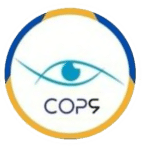What are the main eye diseases that can affect children’s eyes? COP9, a multidisciplinary center specialized in pediatric ophthalmology, presents in this article “Eye diseases in children” different vision disorders in order to raise your awareness and to allow you to effectively take care of your child with our professionals.

Visual disorders
The most frequent visual disorders observed in children, but also in adults, are myopia and hyperopia. How can we recognize the signs that allow us to quickly detect these eye diseases?
A short-sighted child (myopia) has difficulty with distance vision on a daily basis. You can observe this vision problem when the child squints and furrows their eyebrows to look at a distant object, and complains of frequent headaches and visual fatigue. Their blurred vision does not allow them to accurately catch objects around them. They may stand very close to the paper they are writing or drawing on, or move closer to the book or screen they are looking at to compensate for their blurred visual field.
Occurring around the age of six, these symptoms are a sign to make an appointment with the ophthalmologist as soon as possible. An eye exam will then be performed by our professionals in order to obtain a better visual acuity by having the child wear glasses. Corrective lenses compensate for the visual defect of the retina.
A long-sighted child (hypermetropia) will also experience headaches and eye strain as with shortsightedness. Having difficulties in near vision, the child will also see their eyes redden, and will incline their head backwards while half-opening their eyes in order to fix their vision. Often physiological, this disease can be present from birth, during the development of the eye and affects visual acuity. If not corrected by a specialized pediatric ophthalmology team, amblyopia or strabismus may develop.
Non traitées, ces pathologies vont persister au cours de sa vie, il est donc important de savoir reconnaître les symptômes de ce trouble visuel et d’effectuer un suivi ophtalmologique efficace. Suite à un examen de la vision, le port de lunettes de vue permettra de régler cette déficience visuelle.
Retinoblastoma
Retinoblastoma is a cancer of the retina. Its development is observed in young children under the age of 5. This cancer is rare, and is fully treatable when treated quickly. 95% of cases are fully cured.
This pathology can affect one eye as well as both eyes (binocular). In the first case, the screening is done around the 1 or 2 years of age of the child. In the second case, the diagnosis by the ophthalmologist is made earlier, before the child’s first birthday.
If not treated early enough, the cancer can spread to other parts of the body, with more serious consequences ranging from vision problems to blindness. The COP9 team invites you to learn about the symptoms of this childhood eye disease and share this article to raise awareness.
Signs of the pathology
- Increased photosensitivity
- Itchy eyes
- Strabismus
- Eye pain
- vision problems or even loss of sight.
It is also possible to notice a whitening of the pupil, which is particularly noticeable when taking photographs with a flash, or when facing rays of light. This white reflection, also called “cat’s eye”, is one of the signals that the retina is affected by cancer.
Eye diseases and symptoms, when should you be concerned?
There are many different pathologies and vision disorders, some more serious than others, which can be detected in ophthalmology.
In pediatric ophthalmology, many different eye diseases and vision disorders can affect children, some more serious than others. The question is to know when to be concerned, and to consult a specialized ophthalmologist like Dr. Zwillinger.
Sight is a precious sense for your child, it is necessary to take great care of it and to offer your child the best care.
Eye diseases can range from a simple decrease in visual acuity, to dryness of the eyeball, or even retinal detachment.
Signs such as accommodative dysfunction, visual defects, eye pain, headaches, black spots in the visual field or difficulty wearing glasses should alert you.
Whether you see one or more of these cases, or any abnormality, you should make an appointment with your ophthalmologist or go directly to the hospital emergency unit to take care of your child’s eye health.

Great article! It’s important for parents to be aware of common eye diseases in kids so they can take the necessary steps to protect their little ones’ vision.
Thanks a lot for your review Tamara.
COP9 team.
Thanks a lot for your comment Tamara !
COP9 team